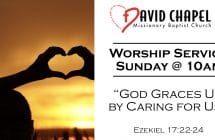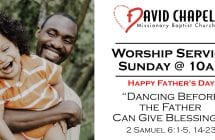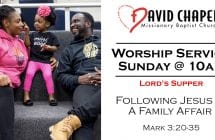The historic origin of David Chapel Missionary Baptist Church was the year 1924, and the site of its beginnings was a blacksmith shop. From that site, this body of believers moved to a tabernacle, a stucco building, and its present site located on the corner of Martin Luther King, Jr. Boulevard and Chestnut Street.
In 1924, a few Christians living in the community of Ceiling Hills (located just south of the city of Austin, near the banks of the Colorado River) became concerned about the way the boys of the community were observing the Lord’s Day—playing marbles. As a result of their concern, a meeting was called by neighbors at the residence of the Horace Davis family. A subsequent meeting was called, and under the able supervision of two ministers, Reverend Ben Wroe and Reverend Connie Alexander, a church was organized on April 27, 1924. The church was named Davis Chapel, in honor of the Horace Davis family, on whose farm it was organized. There were twenty-eight persons who made up the first membership roll.
In another meeting, the Reverend L. M. Marshall was called to lead this newly organized body of Christians. A blacksmith shop was the first dwelling used until October 30, 1926, when the pastor and his members moved from the Ceiling Hills Community to the city of Austin. In Austin, a tabernacle was erected at the corner of 14th and Chestnut Streets. The name of the church was changed to David Chapel. After serving for twelve illustrious years, Reverend L. M. Marshall passed on to his reward on April 17, 1937. Another church in the city of Austin, Rising Star Baptist Church, was born with ten members from David Chapel’s membership.
In 1937, the Reverend S. L. Davis succeeded Reverend Marshall and continued to lead the church in spiritual and financial growth. A house and three lots at the corner of 12th and Chestnut Streets were purchased. After Reverend Davis’ tenure of service, Mt. Calvary was born out of David Chapel’s membership, and the Reverend E. G. Gibbs was called as David Chapel’s pastor in 1940. Under his pastorate, the indebtedness of the church was liquidated. The old tabernacle was torn down, July 4, 1940, and the building of a new $8,000.00 stucco structure began. The indebtedness of this building was paid in less than four years. Another church, Zion Hill, came out of David Chapel’s membership.
The Reverend W. I. Rector succeeded the Reverend Gibbs in 1948. One of the spiritual highlights of Reverend Rector’s ministry was the establishment of the Week Day Church. Serving a short fruitful period of one year and five months, Reverend Rector was called by God to his heavenly reward.
In 1950, the Reverend E. H. Branch answered the Macedonian call of the church, but after answering, with much prayerful deliberation, found that the Spirit did not endorse his coming. Shortly after his departure, the Reverend J. L. Dawson, was called as pastor in 1950. The church membership outgrew its facilities, and in 1958, a larger site was purchased on the corner of 19th (now Martin Luther King, Jr. Blvd.) and Chestnut Streets. The planning, construction, and financing of the new edifice were provided by persons of African-American descent. The architect was John S. Chase (the first African-American to graduate from the University of Texas at Austin in architecture, who died in 2012); the contractor was Oliver B. Street; and the St. John Regular Baptist Association financed our building efforts, which are a testimony of what God can do through His people.
On the first Sunday in January of 1959, Pastor Dawson led the congregation into the new edifice. In October 1963, Reverend Dawson went on to greater fields of endeavor in Fort Worth, Texas, leaving many sad hearts behind.
The Reverend James E. Obey, Sr. was called as pastor in 1963 and arrived on the first Sunday in January 1964. Under his guidance and leadership, many accomplishments were realized, including the air-conditioning of the entire church plant, construction of a new parsonage and sponsorship of the Marshall apartments, a 1.2 million dollar rent supplement housing project, under FHA’s 221 (D) 3 Program. The Church mortgage was burned in 1969. The Church is very proud of this record of solvency brought about by Pastor Obey’s keen foresight and leadership.
On May 18, 1992, God called Pastor Obey home, and the church was greatly saddened by the loss of this great leader. Following the home going of Pastor Obey, the mantle of leadership was placed upon the Reverend Joseph C. Parker, Jr., Esq., D. Min. who was called as pastor on September 29, 1992. Dr. Parker previously served as Associate Pastor for Christian Education for about ten (10) years. Pastor Parker is the first ministerial son of David Chapel to serve as pastor and is our seventh pastor.
Under Pastor Parker’s leadership, the financial and facility management systems have been revised, and we have adopted vision and mission statements. Our facilities have also been refurbished and expanded with new technology and equipment, and other nearby properties have been purchased.
The church staff has been expanded to include an Executive Assistant to the Senior Pastor, Administrative Assistant, and other staff positions. As a “church with a heart for the community,” David Chapel, beginning in 1997, gave leadership to developing and implementing the Chestnut Neighborhood Plan that focuses on revitalizing the Chestnut neighborhood. In 1997, Rev. Beverly Sonnier, an ordained Baptist minister, became the first female staff minister and associate minister, serving as the Minister of Christian Education and Ministries Development. In 1999 we licensed Rev. Beryl Southall as our first female ministerial-daughter to preach the gospel. Rev. Dr. Bernadine S. Davis was the first female ministerial-daughter ordained by David Chapel in 2009, having been licensed in 2001. In July 2000, our website was created and posted on the Internet and was selected as one of the Best Top 32 Church Web Sites for January 2001 by the Distinctive Church Collection and is included in its Hall of Fame. In 2002, we adopted a comprehensive five-year strategic plan that continues to be updated. In 2006 we experimented with a new Saturday evening contemporary and casual worship opportunity, Saturday Night Alive! as well as a Leadership Development Academy. We also became a founding member of the Texas Congregations United for Empowerment, Inc. (TCUE), a collective of Central Texas black churches that seek economic and other empowerment, of which Pastor Parker is the founding president. In 2007 a young adult choir, Joyful Noise, was organized. We also established a Bible study in the North Austin-Pflugerville-Round Rock area, called T.N.T. (Tuesday Night Teaching the Bible) to reach our area members and others. In 2009 we added an 8 a.m. worship service in the North Austin-Pflugerville area, subsequently transferred to our main facility. Through staff reorganization, we established the Minister of Adult Discipleship and Spiritual Formation and Minister of Children, Youth and Young Adults Discipleship positions. As of 2010, our Director of Music responsibilities were expanded to those of a Minister of Music, Worship and Fine Arts. In order to accommodate ministry development and future relocated expansion, we purchased 17 acres on Springdale Road and property on Martin Luther King Jr. Boulevard that adjoins the Springdale property. Architectural conceptual drawings and site planning considerations for this property have been completed, while capital fundraising efforts to finance Phase One of the new facility construction are underway.
As we continually update our efforts to be a transformative church, we continue to focus on the biblical mandate to make disciples of Jesus Christ, as we also plan for our ministries and new facilities. Therefore, continuing in the pattern of the first century church, we study, hear, and do God’s Word. Seeking God’s will and following the leadership and vision God has revealed to our pastor, this church—God’s beacon—gives God all the Glory!



